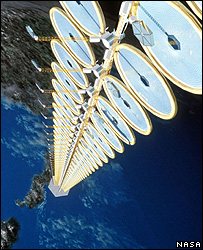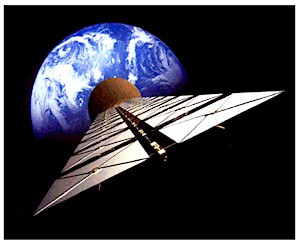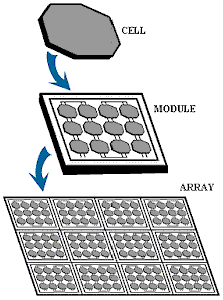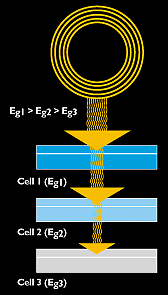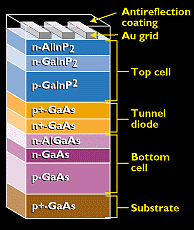|
Mainland High School
Cutting the Cord: ISTF 07-1726 |
||
|
Home
Introduction Components One Two  Product Product
Three Microwave Research W. C. Brown Generators History Phased Arrays Properties Rectennas Semiconductors Solar Satellites Superconductors Moon Research Colonization Helium-3 Fusion Geography Mining Resources Project Assessment Bibliography Glossary Team |
Solar Power Satellite Systems
Space Solar Power, SPS, is a concept that was undertaken by NASA and the Department of Energy. The program involved sending large solar arrays into space and beaming the energy collected from the sun to Earth. While absorbing solar energy in space is hardly a new idea, collecting this energy in mass and beaming it down to Earth is a fairly new one. Widely researched in the late 1970s and then again from 1995-1997, solar power satellites are a possible source of energy that will reduce the use of fossil fuels and the emissions of carbon dioxide gas.
"The worldwide demand for electrical power will rise from 12 billion kilowatt-hours in 1995 to almost 22 billion kilowatt-hours in 2020. To supply this need, 403 gigawatts of new generating capacity will be required by 2020 to meet growing demand and to replace retiring units." J. Dudenhoefer & P. George
Solar arrays for the solar power satellite system come in several designs, the most dominant of which are the "sun-tower" and the "sail-tower." The sun-tower is similar in design to a sunflower, with the flower facing the earth and sending the energy down and the stem and leaves collecting the solar energy. Multi-junction solar cells will be used to collect the power.
The sail-tower is very similar, but has rectangular panels as opposed to the circular ones on the sun-tower. It also uses similar multi-junction solar cells to collect the power. This is primarily a European design. Space-Based Solar Power, SBSP, is another organization working on solar power satellites, and is completely separate from NASA. SBSP is a thirteen organization multinational alliance lead by the NSSO, the National Security Space Office. Some of the other key countries and organizations involved are Japan, the EU, Canada, India, China and Russia. The goal of SBSP is to reduce dependency on oil and coal, and to reduce the the effects of burning fossils fuels on the environment. A solar array will be sent into space that will collect solar energy and then use microwave power transmission (MPT) to beam it back to Earth. Receivers on Earth will be designed to collect this energy with a 90% efficiency. These receivers can be placed over farmland because almost all light makes it through the receiver. The advantage of conducting this outside of NASA is that this will not have to compete with other projects on their budget. The NSSO predicts the array to be functioning in the year 2050. Solar Cells
Solar cells, or photovoltaic cells, are used for turning one type of energy into another. The transformation is from sunlight to electricity. There is an effect known as the photoelectric effect. And this occurs when there are materials that can absorb photons of light, and these photons knock electrons from the atom loose. When these electrons are knocked loose, an electric current is created. The basic solar cell has no whirring gizmos or moving parts. Solar cells are mostly made of silicon. They also contain other molecules called dopants. The two dopants most commonly used are phosphorus and boron. There is also an antireflective coating on the outside of the solar cell to prevent the escape of light. Above you see a basic picture of how solar cells operate. You have the front contact which absorbs the sunlight, and contains the doped silicon molecules. You also see the anti-reflective coating. The outside of the solar cell is generally a specially treated semi-conductor material, and then you have the back contact. Above we have the basic arrangement of solar cells. It begins with just the solar cell, then you put the cells together, and this creates a module. After putting the modules together, you create a solar array. The more area of array or module, the more energy created. When light strikes the arrays, the bombarding photons knock electrons loose from the silicon atoms. Electrostatic fields are created when electrons from the phosphorus layer are inserted into the boron layer. This permanent displacement of the electrons creates an electrostatic field. This electrostatic field makes the electrons flow where they are supposed to, creating electricity. There are different types of solar cells. There are single-junction and multijunction cells. In the single-junction cells, only certain photons can knock loose the electrons. These photons must have an equal or greater band gap than that of the cell material. Therefore, the single-junction cells are limited to the part of the sun's spectrum that is greater than the band-gap of the material. Single-junction cells do not make any use of the lower level energy photons. Even though these single-junction cells don't make much use of lower energy photons, they are still the most commonly used type of solar cell. The multijunction cells make use of many more photons. Below, there is a picture of a multijunction cell. These multijunction cells are stacks of single-junction cells. The layers of these stacks go in a descending order of band gap. So, the top layer absorbs the highest energy photons, the next layer absorbs the next highest, et cetera. Scientists at The University of Toronto have developed spray-on solar cells that have a 6% efficiency rate which is believed to have the potential of 30% efficiency. This is used like paint where it is just painted onto a surface. It is believed that if 0.1% of Earth's surface, or roughly 197000 miles, is covered with solar panels, it could supply all of Earth's energy needs. Researchers combined nano-particles called quantum dots with a polymer to make a plastic that can detect energy in the infrared spectrum. The bonus to this is that there is no need to maintain a "solar farm", only a fresh coat of paint every once in awhile. BBC News - The final frontier for solar energy http://news.bbc.co.uk/1/hi/sci/tech/7131617.stm Free Republic - Spray-On Solar-Power Cells Are True Breakthrough http://209.157.64.200/focus/f-news/1330520/posts GE Energy - How Solar Cells Work http://www.gepower.com/prod_serv/products/solar/en/how_solar_work.htm Georgia Tech - Wireless Power Transmission for Solar Power Satellite http://www.sspi.gatech.edu/wptshinohara.pdf (pg 4-5) HowStuffWorks - How Solar Cells Work http://science.howstuffworks.com/solar-cell.htm Moon Society - Space Solar Alliance for Future Energy http://www.moonsociety.org/reports/space_solar_alliance.html NASA - Solar Power Satellite Technology http://gltrs.grc.nasa.gov/reports/2000/TM-2000-210210.pdf (pg 6) National Central University - Supporting Document for the URSI White Paper on Solar Power Satellite Systems http://www.ss.ncu.edu.tw/~ursi/record/WP_SPS_supdoc_051129.pdf (pg 67-68) National Geographic - Spray-On Solar-Power Cells Are True Breakthrough http://news.nationalgeographic.com/news/2005/01/0114_050114_solarplastic.html National Space Society - Space Based Solar Power http://www.nss.org/settlement/ssp/library/final-sbsp-interim-assessment-release-01.pdf (pg 27) Popular Mechanics - Space-Based Solar Power Beams Become Next Energy Frontier http://www.popularmechanics.com/science/air_space/4230315.html?series=35 Science@NASA - How Do Photovoltaic Cells Work? http://science.nasa.gov/headlines/y2002/solarcells.htm URSI - Report of the URSI Inter-Commission Working Group on SPS http://www.ursi.org/WP/ICWGReport070611.pdf (pg 15) |
